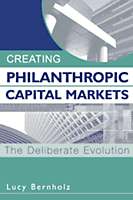Finally, knowledge where you need it
We've been talking about knowledge as a philanthropic resource for a long time (too long, perhaps?) There are some interesting examples out there of how information and knowledge can be shared, packaged and distributed. Below are two, one for free and one for sale. Please send me links to others that you know of that are trying to do these things:
1) Package information in a way that donors and communities can use it for philanthropy
2) Do this in a 'scalable' way - meaning you don't need to rely on being able to reach directly those who are in the know
3) Useful information that actually helps someone make a decision or think about an issue in a different way
4) Is accessible to those with internet access and at a reasonable cost**
Example One: Community Giving Resource
A free website and newsletter from the Neighborhood Funders Group and The Aspen Institute that puts together information and tools gleaned by dozens of professional foundation staff and packages specifically for family foundations without staff and individual donors.
The Community Giving Resources site uses data from DataPlace, an impressive searchable database of census and economic information funded by several major foundations.
From a conservative political perspective, The American Enterprise Institute does a very good job of posting video, audio, and print transcripts, plus papers and presentations from its numerous conferences, on its website, immediately following the events, making the materials available for any who might want them for free for a limited period of time. For example, a recent discussion on philanthropy and education is here.
Example Two: Geneva Global Delta Reports**
**NOTE BENE: This example violates principle #4 above - its not free. Its the opposite. Its expensive.
But it is an interesting example of trying to provide meaningful information to donors based on input from a network of global "stringers" who seek out grassroots opportunities in developing countries for analysis by the staff of this Philadelphia-based firm. More information on their Portfolio Management (A term I coined several years ago in Creating Philanthropic Capital Markets) approach is here
Finally, another very cool approach to sharing information is available from Mitch Kapor, Founder of the Open Source Application Foundation and many other endeavors. Kapor, who created Lotus 1-2-3 and thus made us all need PCs, is now building open source software, specifically a calendar program called Chandler. He blogs about this often, puts beta versions of the program out for user input, and it is open source so by definition it is an exercise in sharing and using knowledge together. All that is great.
What I think is a potentially transferable practice to philanthropy, however, is the diary he shares about making the product. Successes, failures, questions, pitfalls - all for the world to see. Imagine if communities and donors tried the same kind of transparency, inviting in other opinions and advice, making the process open as well as the product, and - I would argue - building a better process and product as a result. Anyone out there in the funding world want to take the courageous leap to share their work this way....?
So, those are my cool examples of knowledge where you need it. Send me yours via email lucy@blueprintrd.com or in the comments. Thanks.
Bookmark this on Del.icio.us




